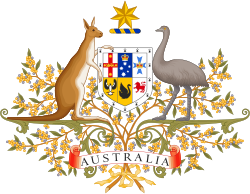2017 Australian federal budget
The 2017 Australian federal budget was the federal budget to fund government services and operations for the 2017–18 financial year. The budget was presented to the House of Representatives by Treasurer Scott Morrison on 9 May 2017. It is the fourth budget to be handed down by the Liberal/National Coalition since their election to government at the 2013 federal election, and the second to be handed down by Morrison and the Turnbull Government.[1]
 | |
| Submitted | 9 May 2017 |
|---|---|
| Submitted by | Turnbull Government |
| Submitted to | House of Representatives |
| Parliament | 45th |
| Party | Liberal/National Coalition |
| Treasurer | Scott Morrison |
| Deficit | A$33.2 billion |
| Website | budget.gov.au |
‹ 2016 2018 › | |
Taxation
The Medicare levy is to increase from 2% to 2.5% of taxable income, with effect on 1 July 2019. The proposed levy increase was scrapped on 25 April 2018.[2]
A bank levy of 0.06% was imposed on the liabilities (ie., deposits) of the five biggest banks (Commonwealth Bank, Westpac, National Australia Bank, ANZ and Macquarie) and was expected to generate $6.2 billion over four years (ie., $1.5 billion each year). The legislation passed parliament on 19 June and came into effect on 1 July 2017.[3]
Broadcasting licence fees worth $90 million paid by free-to-air broadcasting networks are to cease.[4]
The "deficit levy" of 2% on personal incomes over $180,000 will expire on 30 June 2017.[5]
Expenditure
Commonwealth funding for schools will increase by $18.6 billion over 10 years from 2017 to 2027. The Australian Government will invest $5.3 billion into the construction of the Second Sydney Airport over 4 years from 2017 to 2021.[4]
Social security and welfare
Infrastructure, transport and energy
Education
University funding will be a reduced by 2.5%. University fees will go up by $2,000 to $3,600 for a four-year course, an increase of 1.8% in 2018, and 7.5% by 2022. From 1 July 2018, the income level at which HECS debt repayments start will be reduced, from $55,000 to $42,000.[4]
Defence
Health
Opposition and crossbench response
Critical reception
References
- "Budget 2017-18". Budget 2017-18. Archived from the original on 14 May 2009. Retrieved 9 May 2017.
- Turnbull government to scrap $8 billion Medicare levy increase
- Turnbull Government’s $6.2b big bank levy passes Parliament
- "Federal budget 2017: Winners and losers". Australian Broadcasting Corporation. Retrieved 9 May 2017.
- Anderson, Fleur (10 May 2017). "Budget 2017: High income earners win in Medicare levy hike". The Australian Financial Review. Retrieved 22 February 2018.